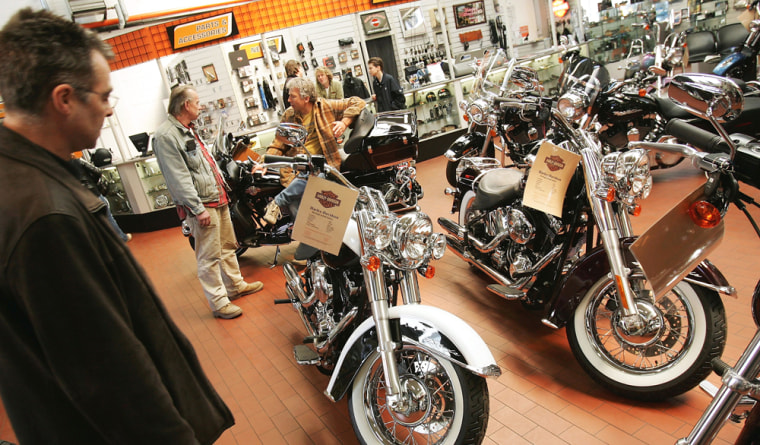Harley-Davidson stock took the worst spill in its history Wednesday after the famed "hog" maker throttled back its 2005 production schedule, saying sales had fallen short of expectations in the first quarter.
The warning overshadowed news of an 11 percent rise in quarterly earnings, and raised questions among analysts about the long-term growth outlook and strategy for Harley-Davidson.
"Management attributed the cuts to slow first-quarter sales, but we think the issue may run deeper than that,” said RBC Capital analyst Ed Aaron. “We think Harley’s underlying (production) growth rate is lower than either management or investors perceive."
The century-old motorcycle maker, based in Milwaukee, said it would cut 2005 production by 10,000 units from its original forecast and now plans to ship 329,000 bikes this year, up just 3.7 percent from a year ago.
Harley's chief financial officer Jim Ziemer, who will take over as CEO this month, said the shortfall in sales was mostly due to poor U.S. weather. He tried to reassure the market that demand exceeds supply and that inventories are in good shape, adding that the first quarter is not indicative of the year’s trends.
"We are taking a precautionary measure by moderating our 2005 shipment schedule to maintain that demand remains in excess of supply," he said in a conference call. “We still have great confidence for the retail sales environment for 2005 — we just have to moderate wholesale shipments this year."
But many analysts on the call continued to seek other reasons for the productions cuts, raising questions about dealer’s inventory levels and higher credit losses. Tony Gikas, an analyst for Piper Jaffray & Co., said his checks with dealers suggested trends had been weakening for eight months.
"There is less confidence in forward bike sales, the level of dealers seeing bikes exceeding expectations is on the decline, and inventories were high,” said Gikas, who has a "market perform” rating on the stock. “Management is still overly optimistic on the longer-term opportunity, ... and what the story lacked today was strategy."
But Jake Balzer, a senior equity analyst at Guzman & Co., called it “a pretty ugly announcement.”
He questioned whether Harley was still too optimistic in its long-term forecasts, which call for unit sales growth of 7 to 9 percent, and earnings growth in the mid-teens.
“The slowdown may already be here," Balzer said. "Everybody just needs to pare down their expectations for this company."
Balzer said Harley’s chief obstacle is its older demographic of buyers — baby boomers with disposable income.
“This baby boomer generation, they’ve got a lot of money, and they’ve spent a lot of money on things like this," he said. "There’s going to be a lag time between the time when they stop buying bikes and the time when they pass that money on to the next generation as an inheritance and they start buying bikes."
For the first quarter, net income rose to $227.2 million, or 77 cents a share, from $204.6 million, or 68 cents a share, a year earlier — topping analysts’ estimates by a penny. Revenue climbed 6 percent to $1.24 billion.
Worldwide sales of motorcycles rose 2.8 percent in the quarter, driven by strong results from Europe and Japan. But retail sales in the U.S. fell about 1 percent from a year earlier.
That resulted in the company’s decision to trim production and cut its earnings growth outlook for the year to about 5 percent to 8 percent, compared with analyst expectations of about 12 percent growth.
Ziemer said the cutback in production, which will take place almost entirely in the second quarter, will cut earnings for the period due to inefficiencies stemming from the disruption.
While the company stood by its long-term growth projections, it backed away from a target of shipping 400,000 bikes in 2007.
"We are still seeing increases in demand, but we are also seeing greater increases in supply,” Gikas said. “I still think there are additional risks to production later this year and certainly to their outlook for 2006 and 2007."
Ted Parrish, a co-portfolio manager of Henssler Equity Fund, said he sold the fund’s stake in Harley-Davidson earlier this month.
"At this stage in the recovery, if and when consumers do decide to pullback on spending, a product considered somewhat upscale that is relying on the marginal consumer to step up to buy (it) is in jeopardy of having a slip-up like they just did," he said.
